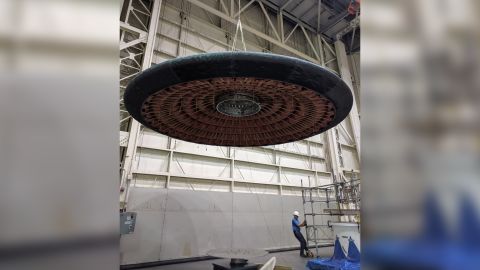Sign up for CNN’s Wonder Theory science newsletter. Explore the universe with news on fascinating discoveries, scientific advancements and more.
CNN
—
When a polar satellite designed to improve weather forecasting launched early Thursday, an experimental heat shield tagged along. It could land humans on Mars.
The two separate missions both launched aboard a United Launch Alliance Atlas V rocket from Space Launch Complex-3 at Vandenberg Space Force Base in Lompoc, California.
Both missions were originally set to lift off on November 1, but a faulty battery on the rocket’s upper stage caused a delay. Engineers exchanged and retested the battery to set the stage for a new launch date.
The National Oceanic and Atmospheric Administration and NASA have been launching weather satellites since 1960. The Joint Polar Satellite System-2, or JPSS-2, will be the third satellite within a fleet of NOAA’s latest generation of polar-orbiting environmental satellites.
The orbiter will collect data that can help scientists predict and prepare for extreme weather events like hurricanes, snowstorms and floods.
The satellite will be able to monitor wildfires and volcanoes, measure the ocean and atmosphere, and detect dust and smoke in the air. It will also monitor the ozone and atmospheric temperature, providing more insight into the climate crisis.
Once it’s in orbit and looping around the planet from the North Pole to the South Pole, the satellite will be renamed NOAA-21. The satellite will observe every spot on Earth at least twice a day, according to NOAA. And when you check the weather on your phone, it will be fed by data captured by the satellite.
The JPSS-2 will join two other satellites, the Suomi National Polar-orbiting Partnership and NOAA-20, that comprise the Joint Polar Satellite System.
“JPSS provides more than twice daily observations over the Atlantic and Pacific Ocean that helps meteorologists monitor weather systems where we do not have the benefit of weather balloons, and only limited buoys, compared to the dense weather station network over land,” said Jordan Gerth, meteorologist and satellite scientist at NOAA’s National Weather Service before the launch.
A secondary payload hitching a ride on the rocket is NASA’s Low-Earth Orbit Flight Test of an Inflatable Decelerator technology demonstration, or LOFTID.
The mission is designed to test the inflatable heat shield technology needed to land crewed missions on Mars and larger robotic missions on Venus or Saturn’s moon Titan. Something like LOFTID could also be used when returning hefty payloads to Earth.
Sending robotic explorers or humans to other worlds that have an atmosphere can be challenging because the current aeroshells, or heat shields, in use depend on the size of a rocket’s shroud.
But an inflatable aeroshell could circumnavigate that dependency — and open up sending heavier missions to different planets.
When a spacecraft enters the atmosphere of a planet, it’s hit with aerodynamic forces, which help slow it down.
On Mars, where the atmosphere is just 1% the density of Earth’s atmosphere, extra help is needed to create the drag necessary to slow and safely land a spacecraft.
That’s why NASA engineers think a large deployable aeroshell like LOFTID, which inflates and is protected by a flexible heat shield, could put on the brakes while traveling down through the Martian atmosphere.
The aeroshell is designed to create more drag in the upper atmosphere to help the spacecraft slow down sooner, which also prevents some of the super-intense heating. The LOFTID demonstration is about 20 feet (6 meters) across.

About 90 minutes after JPSS-2 and LOFITD lift off to space, the tech demo will peel away from the polar satellite once it reaches orbit and LOFTID’s incredibly short mission will commence.
After inflating, LOFTID will be reoriented by the rocket’s upper stage.
Then, the aeroshell will separate from the upper stage and attempt to reenter the atmosphere from low-Earth orbit to see if the heat shield is effective in slowing it down and surviving.
Sensors aboard LOFTID will record the heat shield’s experience during its harrowing descent. Six cameras will capture 360-degree video of LOFTID’s experiment, said Joe Del Corso, LOFTID project manager at NASA’s Langley Research Center.
Upon reentry, LOFTID will face temperatures that reach 3,000 degrees Fahrenhei and hit speeds of nearly 18,000 miles per hour. It will be the ultimate test for the materials used to construct the inflatable structure, which includes a woven ceramic fabric called silicon carbide.
It is expected to splash down about 500 miles off the coast of Hawaii, where a team will recover the aeroshell.
Currently, NASA can land one metric ton (2,205 pounds) on the Martian surface, like the car-size Perseverance rover. But something like LOFTID could land between 20 to 40 metric tons (44,092 to 88,184 pounds) on Mars, Del Corso said.
The results of Thursday’s demonstration could determine the entry, descent and landing technology that one day delivers human crews to the surface of Mars.
Source : Nbcnewyork









